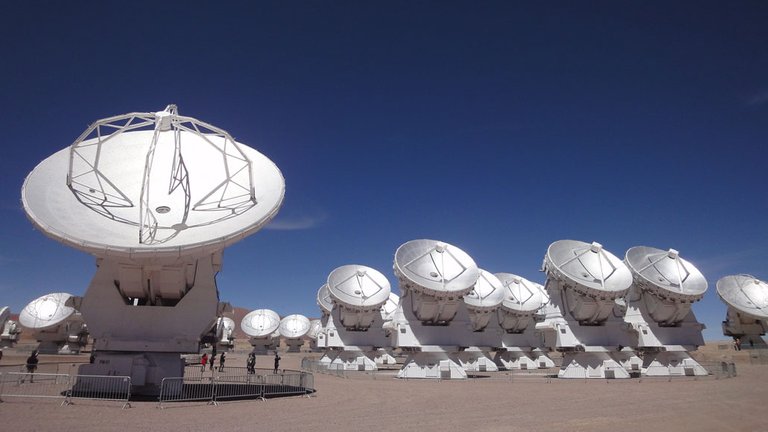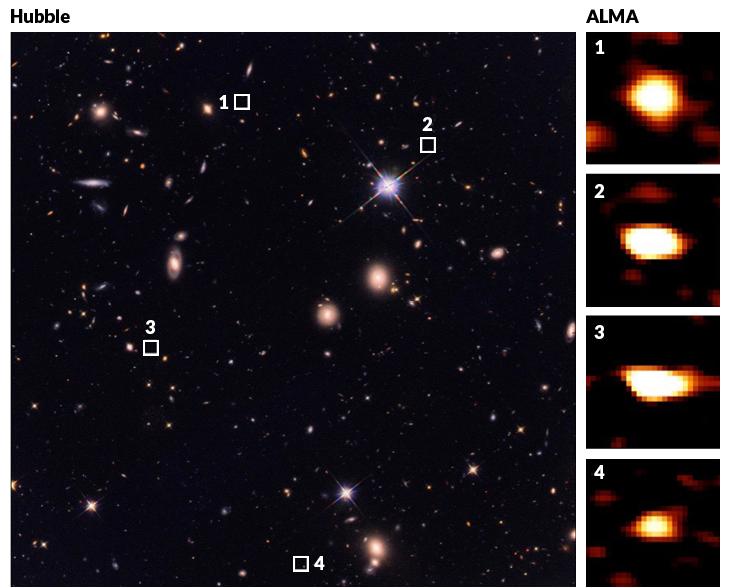
Astronomers may finally have laid eyes on a population of enormous but elusive galaxies in the early universe.
These hefty, star-forming galaxies are shrouded in dust, which hid them from previous searches that used starlight. Now observations of radiation emitted by that interstellar dust have revealed dozens of massive, active galaxies from when the universe was younger than 2 billion years, researchers report online August 7 in Nature. These galaxies may be the long-sought precursors to heavyweight galaxies seen later in the universe’s history, as well as the most massive galaxies around today.
Big, inactive galaxies have been found dating back to a couple billion years after the Big Bang (SN Online: 3/14/14). But the formation of those gentle giants has remained mysterious. That’s because astronomers expect such massive, inactive galaxies to originate from big, star-forming powerhouses, and surveys of the earliest cosmos hadn’t uncovered a population of such star-forming progenitor galaxies.
Using the Atacama Large Millimeter/submillimeter Array, or ALMA, in Chile to examine distant galactic dust emissions, astronomers identified 39 star-forming galaxies from when the universe was about 1 billion to 2 billion years old. These galaxies, which boast an average mass of about 40 billion suns and form about 200 new suns per year, are about as common as the large, inactive galaxies seen slightly later in cosmic history.

“This is definitely a plausible population that could give rise to the quiescent galaxies,” says Karl Glazebrook, an astronomer at Swinburne University of Technology in Melbourne, Australia, not involved in the work.
The newly identified galaxies are also embedded in that early era’s most massive dark matter halos — blobs of invisible, unidentified particles that surround galaxies (SN: 3/3/18, p. 8). The finding suggests that those ancient galaxies are the ancestors of today’s biggest galaxies, which now sit in the most massive dark matter halos, says study coauthor Tao Wang, an astronomer at the University of Tokyo. These modern descendants may include behemoths like M87, home to the first black hole ever imaged (SN: 4/27/19, p. 6).
Astronomer Caitlin Casey at the University of Texas at Austin calls the new galaxy detections “exciting and tantalizing.” But she cautions that the current analysis of ALMA observations, in which she was not involved, gives only rough estimates of how far these galaxies date back in cosmic history. Further investigations with ALMA or NASA’s James Webb Space Telescope, launching in 2021, could help cinch the galaxies’ precise ages and roles in galactic evolution.
The discovery of such big, star-forming galaxies when the universe was less than 2 billion years old fits well with past observations of big, quiescent galaxies later in cosmic history. But these observations don’t jibe with current theories of galaxy formation. In computer simulations, the universe at 2 billion years old contains too few massive galaxies to explain ALMA’s observations, says Williams, the Arizona astronomer. “This is a surprise the universe had for us.”
Wang and colleagues now plan to take a larger census of ancient massive galaxies with ALMA. That work could give theorists more information about how to tweak cosmological simulations to match early-universe observations.
Source
Plagiarism is the copying & pasting of others work without giving credit to the original author or artist. Plagiarized posts are considered spam.
Spam is discouraged by the community, and may result in action from the cheetah bot.
More information and tips on sharing content.
If you believe this comment is in error, please contact us in #disputes on Discord
STEM rewards have been removed from this content.
Hi! I am a robot. I just upvoted you! I found similar content that readers might be interested in:
https://www.sciencenews.org/article/giant-active-galaxies-early-universe-may-have-finally-been-found
Congratulations @hoarder! You have completed the following achievement on the Steem blockchain and have been rewarded with new badge(s) :
You can view your badges on your Steem Board and compare to others on the Steem Ranking
If you no longer want to receive notifications, reply to this comment with the word
STOPVote for @Steemitboard as a witness to get one more award and increased upvotes!